Verona Arena: Roman Amphitheatre
Table of Contents
History of Verona’s ancient amphitheatre
Introduction to Verona Arena
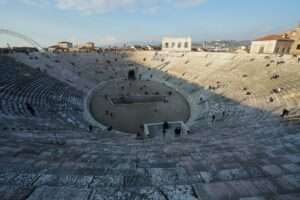 The Verona Arena is a Roman amphitheatre situated in the historic center of Verona, Italy. It is recognized as one of the best-preserved ancient amphitheatres in the world. This structure exemplifies Roman architectural design and has survived through various transformations over the centuries. Its preservation is largely attributed to restoration efforts that began in the 16th century. These efforts have allowed visitors to appreciate the original design and purpose of such buildings.
The Verona Arena is a Roman amphitheatre situated in the historic center of Verona, Italy. It is recognized as one of the best-preserved ancient amphitheatres in the world. This structure exemplifies Roman architectural design and has survived through various transformations over the centuries. Its preservation is largely attributed to restoration efforts that began in the 16th century. These efforts have allowed visitors to appreciate the original design and purpose of such buildings.
During the summer months, the Verona Arena becomes the venue for the Arena di Verona Festival. This festival features opera performances that have been held continuously since 1913. Throughout the rest of the year, the Arena hosts a variety of international music events, showcasing a range of artists and genres.
Historic Context
Construction
Determining the exact construction date of the Verona Arena is challenging due to the lack of written records. Scholars have proposed dates ranging from the 1st to the 3rd century AD. To refine the dating of the Arena, researchers have compared it to the amphitheatre in Pula, which shares similar stylistic and technical features. Both structures are located in the same geographical region, leading to hypotheses that they may have been designed by the same architect. The Pula amphitheatre is generally dated to the Augustan period, indicating that the Verona Arena was likely constructed around the same time.
Additional evidence for dating includes the amphitheatre’s decorations and a life-sized tuff gladiator’s head found at the site. This helmet style, which emerged around 10–20 AD, suggests that the Arena was completed by approximately 30 AD.
Ancient History
 Much of the ancient history of the Verona Arena remains unclear. However, it is known that the city of Verona played a role in the conflict between Vitellius and Vespasian. Vespasian chose Verona as a stronghold due to its favorable terrain for cavalry deployment. To enhance the city’s defenses, he ordered the construction of a rampart and the excavation of the Adigetto, a moat that remained in use into the Middle Ages. This indicates that the Arena was already built by 69 AD.
Much of the ancient history of the Verona Arena remains unclear. However, it is known that the city of Verona played a role in the conflict between Vitellius and Vespasian. Vespasian chose Verona as a stronghold due to its favorable terrain for cavalry deployment. To enhance the city’s defenses, he ordered the construction of a rampart and the excavation of the Adigetto, a moat that remained in use into the Middle Ages. This indicates that the Arena was already built by 69 AD.
Emperor Gallienus faced challenges from barbarian invasions in the 3rd century. He utilized Verona as part of his defense strategy, which included refurbishing the city’s walls and constructing a new section to encompass the Arena. Excavations in 1874 revealed the foundations of these walls, confirming the Arena’s continued use for spectacles.
There are unconfirmed accounts suggesting that the Arena may have been the site of Christian martyrdom. Historical speculation indicates that certain martyrs were executed there around 304 AD. In 312 AD, Verona was involved in the conflict between Constantine and Maxentius, with the Arena serving as a defensive position during the siege. This event is documented in a panegyric to Constantine and depicted in reliefs on the Arch of Constantine.
Medieval History
During the Romano-Germanic kingdom of Theodoric the Great, the Verona Arena likely underwent maintenance and hosted spectacles. Medieval chronicles often attributed its construction to Theodoric. However, significant damage occurred during his reign, as parts of the outer ring were demolished to provide materials for defensive walls. Despite this, the Arena retained its functionality for hosting events.
Natural disasters also impacted the Arena, including floods and earthquakes. In the 13th century, efforts to restore the amphitheatre began, coinciding with legal battles held within its walls. These contests involved professional fighters, known as champions, who determined the outcomes of trials through combat. Notably, Dante referenced such events in his writings.
In 1278, under Alberto I della Scala, heretics were executed within the Arena. Regulations were established regarding its use, including provisions for the presence of prostitutes. These regulations reflect the ongoing significance of the Arena in the community, as it continued to host various events, including jousts and festivities.
Early Modern History
In 1450, the Venetian government implemented new statutes for the Arena, emphasizing its importance to the city. These regulations aimed to maintain cleanliness and prevent damage to the structure. The Renaissance period saw a renewed interest in the Arena’s architectural significance, with artists and architects studying it for preservation purposes.
By the mid-16th century, Verona initiated efforts to protect and restore its antiquities. A key step was the redemption of the Arena from the University of Citizens, allowing for the expulsion of residents and the beginning of restoration work. Restoration efforts occurred in the late 17th and early 18th centuries, focusing on the cavea and other structural elements.
In 1590, the first documented joust took place inside the Arena, marking a shift in its use. The 17th century saw a transition from equestrian events to theatrical performances, with notable productions staged within the amphitheatre. The popularity of daytime spectacles grew, culminating in a variety of entertainment forms, including bull hunting and theatrical performances.
Contemporary History
Under French rule in 1805, Napoleon Bonaparte visited the Arena and allocated funds for its restoration. Subsequent efforts focused on preserving the structure and enhancing its functionality. The establishment of the Deputation for Public Ornament in 1807 marked a commitment to the Arena’s preservation.
In the 19th century, the Arena continued to host various events, including bull hunts and theatrical performances. The first opera season began in 1856, establishing the Arena as a prominent venue for cultural events. Following Italy’s unification in 1866, the Arena remained a significant site for civic celebrations and military events.
From the early 1900s, the Arena became known for its circus performances and eventually transitioned to opera, with the Arena di Verona Festival beginning in 1913. This festival solidified the amphitheatre’s role as a major open-air opera venue, attracting international attention and preserving its historical significance.
The Amphitheatre
The Verona Arena was constructed outside, but close to the Republican city walls. This positioning indicates that it was not part of the original city plan. The amphitheatre’s location outside the walls suggests that the city was fully developed at the time of its construction. This necessitated a rethinking of road networks to accommodate the influx of spectators.
The amphitheatre’s external position facilitated access from surrounding areas, drawing large audiences for events. The orientation of the structure aligns with the urban grid, connecting its drainage system to the city’s infrastructure. This strategic placement underscores the Arena’s significance in the urban landscape of ancient Verona.
Several inscriptions found near the Verona Arena provide insights into its history. One inscription records a bequest for the construction of a statue of Diana and a hunting spectacle. Another inscription indicates a specific seating location within the amphitheatre, reflecting its organized structure.
The foundational layout of the Verona Arena is elliptical, with the arena measuring 75.68 m by 44.43 m. The cavea spans 39.40 m, and the amphitheatre’s maximum dimensions rank it among the largest in the Roman world. The structure was built on an artificial elevation, with a sophisticated drainage system to manage rainwater.
The current appearance of the Verona Arena differs from its original form, particularly due to the loss of the outer ring. The surviving segment, known as the Ala, features four arches and serves as a remnant of the original facade. The three-tiered arcades express the architectural complexity of the structure.
The interior of the amphitheatre consists of concentric galleries that divide the structure into zones. The seating tiers are organized with vomitoria staircases providing access to different levels. The grand entrance, facing Porta Borsari, is notably larger than others, indicating its significance for spectators.
The construction of the Verona Arena utilized standardized techniques and materials, primarily red ammonitic limestone.
Estimates suggest that the Verona Arena could accommodate around 30,000 spectators during Roman times. This capacity reflects the city’s population and the amphitheatre’s role as a major entertainment venue.
Various legends have emerged regarding the origins of the Verona Arena. One tale involves a nobleman who promised to build the amphitheatre overnight, bargaining with the devil. Another legend attributes its construction to the Devil due to its immense size.
Nearby sites
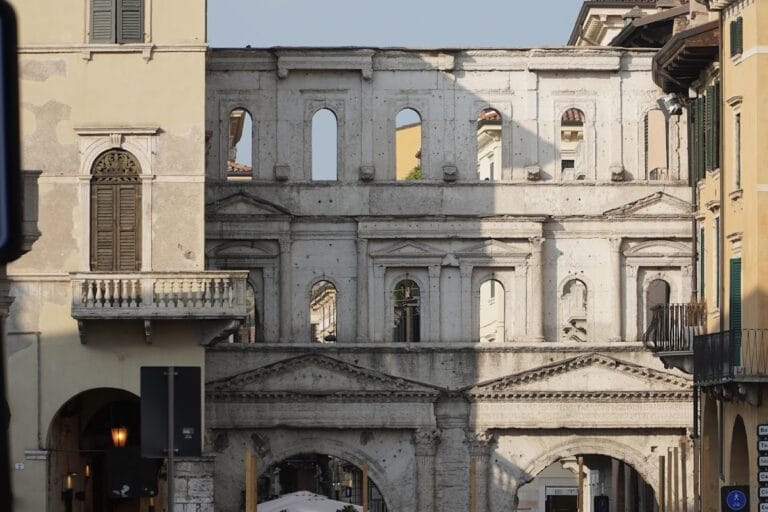
Porta Borsari: The Historic Roman Gate of Verona
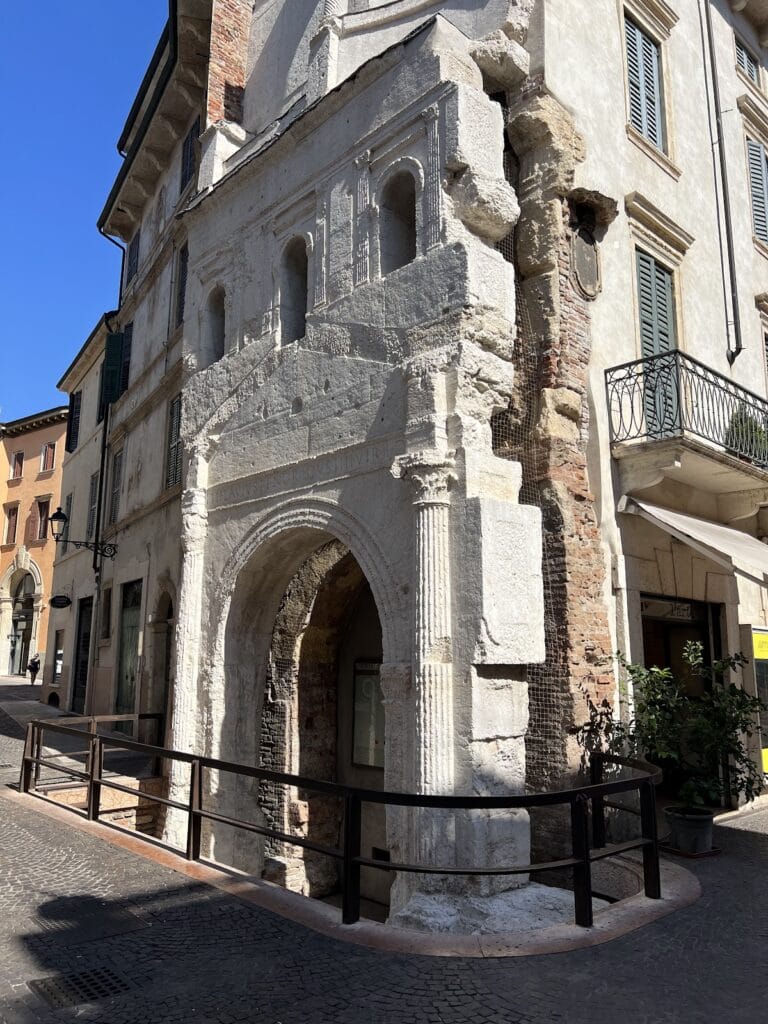
Porta Leoni, Verona: A Roman City Gate Reflecting Ancient Urban Defense

Arco dei Gavi: A Roman Monument in Verona
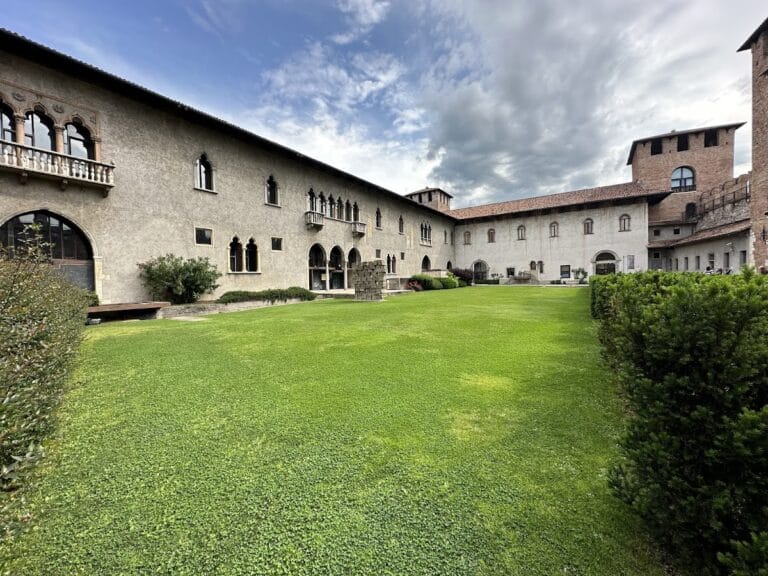
Castelvecchio: Verona’s Historic Medieval Fortress and Museum
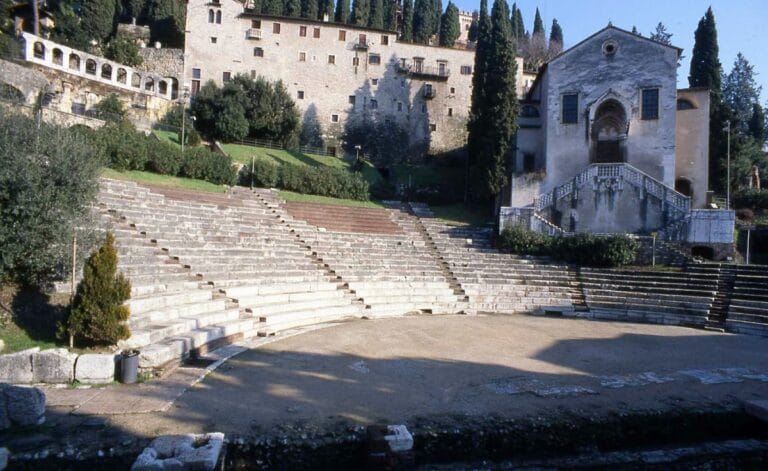
Museo Archeologico al Teatro Romano, Verona: Preserving Roman Heritage
